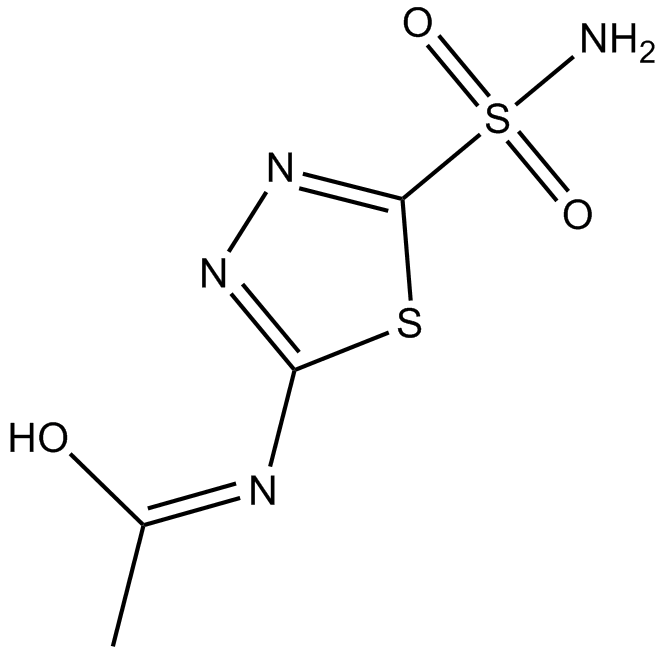Acetazolamide (Synonyms: L-579,486, NSC 145177) |
| Catalog No.GC11567 |
carbonic anhydrase (CA) inhibitor
Products are for research use only. Not for human use. We do not sell to patients.

Cas No.: 59-66-5
Sample solution is provided at 25 µL, 10mM.
Acetazolamide is a carbonic anhydrase (CA) IX inhibitor with an IC50 of 30 nM for hCA IX[1]. Diuretic effects[4].
Acetazolamide also inhibits hCA II with an IC50 of 130 nM[1].
Acetazolamide (Ace) is a small heteroaromatic sulfonamide that binds to various carbonic anhydrases with high affinity, acting as a carbonic anhydrase (CA) inhibitor[2].
Compared with the control group, the high Acetazolamide concentration (AceH, 50 nM), Cisplatin (Cis; 1 µg/mL) and Cis combined with the low Acetazolamide concentration (AceL, 10 nM) treatments significantly reduces viability of Hep-2 cells[2].
Treatment with the Acetazolamide/Cis combination significantly increases the expression levels of P53, as both AceL+Cis and AceH+Cis treatments result in significantly increased P53 protein expression levels compared with the control group. The Ace/Cis combination treatment significantly reduces the bcl-2/bax expression ratio, and increases the expression of caspase-3 protein, compared with the control group. AceL, AceH, Cis and AceL+Cis treatments significantly reduce the bcl-2/bax ratio compared with the control group[2].
Combined Ace and Cis treatment effectively promotes apoptosis in Hep-2 cells[2].
Combined treatment with Ace/Cis markedly decreases the expression of AQP1 mRNA in Hep-2 cells. Both AceH and AceL+Cis treatments decrease the expression of aquaporin-1 (AQP1) mRNA in Hep-2 cells compared with the control group[2].
Acetazolamide (40 mg/kg) significantly potentiates the inhibitory effect of MS-275 on tumorigenesis in neuroblastoma (NB) SH-SY5Y xenografts[3].
Acetazolamide (40 mg/kg) and/or MS-275 treatment reduce expression of HIF1-α and CAIX in NB SH-SY5Y xenograft[3].
Acetazolamide (40 mg/kg), MS-275 and Acetazolamide+MS-275 reduce expression of mitotic and proliferative markers in NB SH-SY5Y xenografts[3].
Reference:
[1]. Hou Z, et al. Dual-tail approach to discovery of novel carbonic anhydrase IX inhibitors by simultaneously matching the hydrophobic and hydrophilic halves of the active site. Eur J Med Chem. 2017 May 26;132:1-10.
[2]. Bayat Mokhtari R, et al. Acetazolamide potentiates the anti-tumor potential of HDACi, MS-275, in neuroblastoma. BMC Cancer. 2017 Feb 24;17(1):156.
[3]. Gao H, et al. Combined treatment with acetazolamide and cisplatin enhances chemosensitivity in laryngeal carcinoma Hep-2 cells. Oncol Lett. 2018 Jun;15(6):9299-9306.
[4]. Kassamali R, et al. Acetazolamide: a forgotten diuretic agent. Cardiol Rev. 2011 Nov-Dec;19(6):276-8.
Average Rating: 5 (Based on Reviews and 24 reference(s) in Google Scholar.)
GLPBIO products are for RESEARCH USE ONLY. Please make sure your review or question is research based.
Required fields are marked with *




















